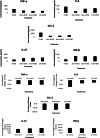In vitro anti-influenza assessment of anionic compounds ascorbate, acetate and citrate
- PMID: 35606770
- PMCID: PMC9125540
- DOI: 10.1186/s12985-022-01823-0
In vitro anti-influenza assessment of anionic compounds ascorbate, acetate and citrate
Erratum in
-
Correction to: In vitro anti-influenza assessment of anionic compounds ascorbate, acetate and citrate.Virol J. 2022 Jun 21;19(1):105. doi: 10.1186/s12985-022-01832-z. Virol J. 2022. PMID: 35729614 Free PMC article. No abstract available.
Abstract
Background: Influenza A virus (IAV) infection remains a serious public health threat. Due to drug resistance and side effects of the conventional antiviral drugs, repurposing the available natural compounds with high tolerability and fewer side effects has attracted researchers' attention. The aim of this study was to screen in vitro anti-influenza activity of three anionic compounds ascorbate, acetate, and citrate.
Methods: The non-cytotoxic concentration of the compounds was determined by MTT assay and examined for the activity against IAV in simultaneous, pre-, and post-penetration combination treatments over 1 h incubation on Madin-Darby Canine Kidney (MDCK) cell line. The virus titer and viral load were determined using hemagglutination assay (HA) and qPCR, respectively. Few pro-inflammatory and anti-inflammatory cytokines were evaluated at RNA and protein levels by qPCR and ELISA, respectively.
Results: The non-cytotoxic concentrations of the ascorbate (200 mg/ml), acetate and citrate (both 3 mg/ml) reduced the viral titer by 6.5, 4.5, and 1.5 logs in the simultaneous combination treatment. The M protein gene copy number decreased significantly in simultaneous treatment (P < 0.01). The expression of cytokines was also affected by the treatment of these compounds.
Conclusions: These anionic compounds could affect the influenza virus load, thereby reducing pro-inflammatory cytokines and increasing anti-inflammatory cytokines levels.
Keywords: Acetate; Ascorbate; Citrate; Cytokine; Influenza A virus.
© 2022. The Author(s).
Conflict of interest statement
Authors declare that they have no conflicts of interest.
Figures



Similar articles
-
Immunomodulatory properties of quercetin-3-O-α-L-rhamnopyranoside from Rapanea melanophloeos against influenza a virus.BMC Complement Altern Med. 2018 Jun 15;18(1):184. doi: 10.1186/s12906-018-2246-1. BMC Complement Altern Med. 2018. PMID: 29903008 Free PMC article.
-
Evaluation of the antiviral potential of gemini surfactants against influenza virus H1N1.Arch Microbiol. 2023 Apr 11;205(5):184. doi: 10.1007/s00203-023-03478-z. Arch Microbiol. 2023. PMID: 37039867 Free PMC article.
-
Aurantiamide acetate from baphicacanthus cusia root exhibits anti-inflammatory and anti-viral effects via inhibition of the NF-κB signaling pathway in Influenza A virus-infected cells.J Ethnopharmacol. 2017 Mar 6;199:60-67. doi: 10.1016/j.jep.2017.01.038. Epub 2017 Jan 21. J Ethnopharmacol. 2017. PMID: 28119097
-
Antiviral activity of hydroalcoholic extract from Eupatorium perfoliatum L. against the attachment of influenza A virus.J Ethnopharmacol. 2016 Jul 21;188:144-52. doi: 10.1016/j.jep.2016.05.016. Epub 2016 May 10. J Ethnopharmacol. 2016. PMID: 27178637
-
Experimental validation and computational modeling of anti-influenza effects of quercetin-3-O-α-L-rhamnopyranoside from indigenous south African medicinal plant Rapanea melanophloeos.BMC Complement Altern Med. 2019 Dec 2;19(1):346. doi: 10.1186/s12906-019-2774-3. BMC Complement Altern Med. 2019. PMID: 31791311 Free PMC article.
Cited by
-
Correction to: In vitro anti-influenza assessment of anionic compounds ascorbate, acetate and citrate.Virol J. 2022 Jun 21;19(1):105. doi: 10.1186/s12985-022-01832-z. Virol J. 2022. PMID: 35729614 Free PMC article. No abstract available.
-
In Vitro Antiviral and Anti-Inflammatory Activities of N-Acetylglucosamine: Development of an Alternative and Safe Approach to Fight Viral Respiratory Infections.Int J Mol Sci. 2023 Mar 7;24(6):5129. doi: 10.3390/ijms24065129. Int J Mol Sci. 2023. PMID: 36982205 Free PMC article.
References
MeSH terms
Substances
LinkOut - more resources
Full Text Sources
Medical

